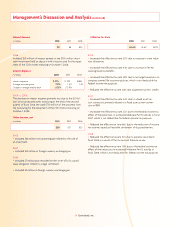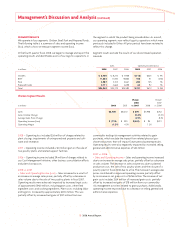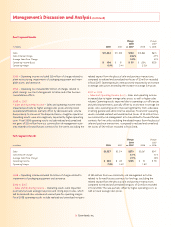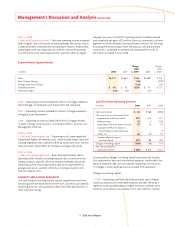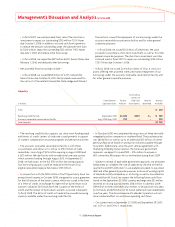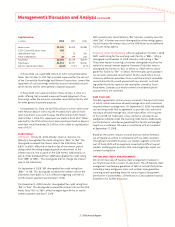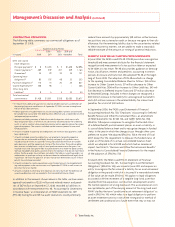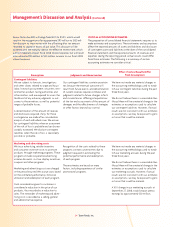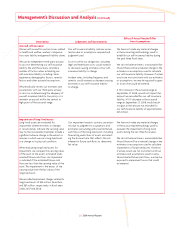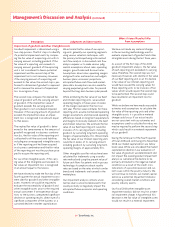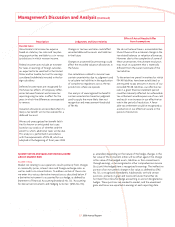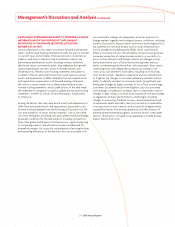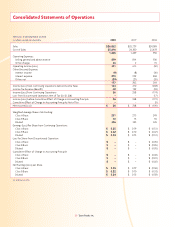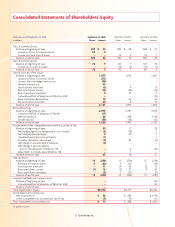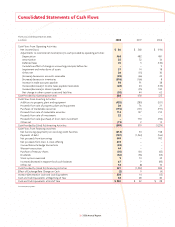Tyson Foods 2008 Annual Report Download - page 25
Download and view the complete annual report
Please find page 25 of the 2008 Tyson Foods annual report below. You can navigate through the pages in the report by either clicking on the pages listed below, or by using the keyword search tool below to find specific information within the annual report.
23 2008 Annual Report
Management’s Discussion and Analysis (continued)
be within the control of the entity. FIN 47 requires an entity to
recognize a liability for the fair value of a conditional asset retire-
ment obligation if the fair value of the liability can be reasonably
estimated. Uncertainty about the timing and/or method of settlement
of a conditional asset retirement obligation should be factored into
the measurement of the liability when suffi cient information exists.
We adopted FIN 47 as of September 30, 2006. See Note 2, “Change
in Accounting Principle” in the Notes to Consolidated Financial State-
ments for the impact of the adoption of FIN 47.
RECENTLY ISSUED ACCOUNTING PRONOUNCEMENTS
In September 2006, the FASB issued Statement of Financial Accounting
Standards No. 157, “Fair Value Measurements” (SFAS No. 157). SFAS No. 157
provides guidance for using fair value to measure assets and liabilities.
This standard also responds to investors’ requests for expanded
information about the extent to which companies measure assets
and liabilities at fair value, the information used to measure fair value
and the effect of fair value measurements on earnings. SFAS No. 157
applies whenever other standards require (or permit) assets or liabil-
ities to be measured at fair value. Beginning September 28, 2008,
we partially applied SFAS No. 157 as allowed by FASB Staff Position
(FSP) 157-2, which delayed the effective date of SFAS No. 157 for
nonfi nancial assets and liabilities. As of September 28, 2008, we have
applied the provisions of SFAS No. 157 to our fi nancial instruments
and the impact was not material. Under FSP 157-2, we will be required
to apply SFAS No. 157 to our nonfi nancial assets and liabilities at the
beginning of fi scal 2010. We are currently reviewing the applicability
of SFAS No. 157 to our nonfi nancial assets and liabilities as well as the
potential impact on our consolidated fi nancial statements.
In February 2007, the FASB issued Statement of Financial Accounting
Standards No. 159, “The Fair Value Option for Financial Assets and
Financial Liabilities, including an amendment of FASB Statement
No. 115” (SFAS No. 159). This statement provides companies with an
option to report selected fi nancial assets and liabilities fi rm commit-
ments, and nonfi nancial warranty and insurance contracts at fair value
on a contract-by-contract basis, with changes in fair value recognized
in earnings each reporting period. At September 28, 2008, we did not
elect the fair value option under SFAS No. 159 and therefore there
was no impact to our consolidated fi nancial statements.
In December 2007, the FASB issued Statement of Financial Accounting
Standards No. 160, “Noncontrolling Interests in Consolidated Finan-
cial Statements” (SFAS No. 160). SFAS No. 160 amends Accounting
Research Bulletin No. 51, “Consolidated Financial Statements” to
establish accounting and reporting standards for a noncontrolling
interest in a subsidiary and for the deconsolidation of a subsidiary.
This statement clarifi es that a noncontrolling interest in a subsidiary is
an ownership interest in the consolidated entity and should be
reported as equity in the consolidated fi nancial statements, rather
than in the liability or mezzanine section between liabilities and
equity. SFAS No. 160 also requires consolidated net income be
reported at amounts that include the amounts attributable to
both the parent and the noncontrolling interest. The impact of
SFAS No. 160 will not have a material impact on our current
Consolidated Financial Statements. SFAS No. 160 is effective for
fi scal years, and interim periods within those fi scal years, beginning
on or after December 15, 2008; therefore, we expect to adopt SFAS
No. 160 at the beginning of fi scal 2010.
In December 2007, the FASB issued Statement of Financial Account-
ing Standards No. 141R, “Business Combinations” (SFAS No. 141R). SFAS
No. 141R establishes principles and requirements for how an acquirer
in a business combination: 1) recognizes and measures in its fi nancial
statements identifi able assets acquired, liabilities assumed, and any
noncontrolling interest in the acquiree; 2) recognizes and measures
goodwill acquired in a business combination or a gain from a bargain
purchase; and 3) determines what information to disclose to enable
users of the fi nancial statements to evaluate the nature and fi nancial
effects of a business combination. SFAS No. 141R is effective for busi-
ness combinations for which the acquisition date is on or after the
beginning of the fi rst annual reporting period beginning on or after
December 15, 2008; therefore, we expect to adopt SFAS No. 141R for
any business combinations entered into beginning in fi scal 2010.
In March 2008, the FASB issued Statement of Financial Accounting
Standards No. 161, “Disclosures about Derivative Instruments and
Hedging Activities – an amendment of FASB Statement No. 133” (SFAS
No. 161). SFAS No. 161 establishes enhanced disclosure requirements
about: 1) how and why an entity uses derivative instruments; 2) how
derivative instruments and related hedged items are accounted
for under Statement 133 and its related interpretations; and 3) how
derivative instruments and related hedged items affect an entity’s
fi nancial position, fi nancial performance and cash fl ows. SFAS No. 161
is effective for fi nancial statements issued for fi scal years and interim
periods beginning after November 15, 2008; therefore, we expect to
adopt SFAS No. 161 in the second quarter of fi scal 2009.
In May 2008, the FASB issued FASB Staff Position No. APB 14-1,
“Accounting for Convertible Debt Instruments That May Be Settled
in Cash upon Conversion (Including Partial Cash Settlement)” (FSP
APB 14-1). FSP APB 14-1 specifi es that issuers of convertible debt
instruments that may be settled in cash upon conversion (including
partial cash settlement) should separately account for the liability
and equity components in a manner that will refl ect the entity’s non-
convertible debt borrowing rate when interest cost is recognized in
subsequent periods. The amount allocated to the equity component
represents a discount to the debt, which is amortized into interest
expense using the effective interest method over the life of the debt.
FSP APB 14-1 is effective for fi nancial statements issued for fi scal years
beginning after December 15, 2008, and interim periods within those
fi scal years. Early adoption is not permitted. Therefore, we expect to
adopt the provisions of FSP APB 14-1 beginning in the fi rst quarter of
fi scal 2010. The provisions of FSP APB 14-1 are required to be applied
retrospectively to all periods presented. Upon retrospective adoption,
we anticipate our effective interest rate on our 3.25% Convertible



